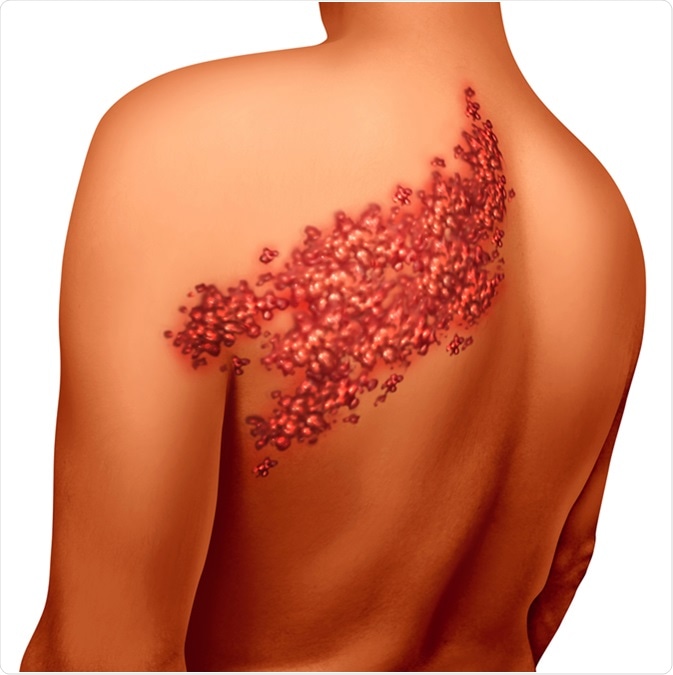Shingles also referred to as herpes zoster is a type of viral infection that develops on one side of the face or body. This is an extremely painful condition and manifests as a single stripe of blisters and covers the right or left side of the torso. Vaccination can help prevent shingles, and an early treatment can decrease the time span of the infection and extent of the complications.

Cause and Transmission
The causative agent for shingles is varicella zoster virus (VZV) and the infection with the same virus results in chickenpox. The individual affected by chickenpox once in the lifetime is more susceptible to encounter shingles. VZV enters the sensory neurons during childhood infection of chickenpox. VZV stays dormant in the body after chickenpox, but it manifests into an active state and causes shingles.
Children and adults both are prone to shingles; however, the chances are high in older individuals. Immunocompromised patients affected with conditions such as leukaemia, lymphoma, human immunodeficiency virus (HIV) or the individuals on immunosuppressive drugs are more likely to be affected with shingles. Shingles usually affect only once in a lifetime; however, a person may also encounter a second or third episode.
Shingles is a non-communicable disease, however, a person having active shingles can transmit the infection to a healthy individual who either never had chickenpox or had not received vaccination for the same. This condition manifests in the form of blisters, which contain fluid. Upon a direct contact, the fluid transmits the virus.
Nerve Damage – a Major Complication
Postherpetic neuralgia is the most common chronic complication of herpes zoster, and it affects nerve fibers and skin. In a person who has ever been affected by chickenpox in the past, dormant varicella zoster virus (VZV) is re-activated in a sensory ganglion. About 10-18% of individuals who had ever suffered from chickenpox develop postherpetic neuralgia. It is an extremely painful condition. An acutely painful vesicular rash targets a single dermatome (area on the skin supplied by single spinal nerve).
Signs and Symptoms of Postherpetic Neuralgia
The symptoms of postherpetic neuralgia are confined to a focused (limited) area, where the shingles manifest at first. However, the symptoms and pain may spread to other areas usually once the original outbreak resolves.
Signs and symptoms usually include:
- Pain lasting for 3 months or more: A burning, sharp, or deep pain, which lasts post the shingles rash subsides. The pain may also be linked to disrupted sensory feedback throughout the body.
- Sensitivity even on light touch: Patients usually complain of hypersensitivity in other parts of the body and become sensitive to touch, even to the light clothing. This condition is also known as allodynia.
- Itchy skin and numbness: At times the patient may also experience itchiness or numbness.
Some rare situations may also show muscle tremor, muscle weakness, or even paralysis when motor nerves are involved.
Postherpetic neuralgia may further complicate to conditions such as depression, fatigue, insomnia and anorexia.
Prevention: Vaccination includes the chickenpox (varicella) vaccine and the shingles (varicella-zoster) vaccine. Both children and adult can benefit from the vaccination. Even the geriatrics who are not allergic to the vaccine and are not on any immunosuppressive medications can benefit from the vaccination.
Shingles and Facial Nerve Damage
Herpes zoster oticus (HZ oticus) is a type of shingles which is restricted to the area in and around the ear, and majorly affects the nerves supplying the ear. HZ oticus usually affects the individuals who have been affected by chickenpox in their life.
This condition can lead to serious deformities such as hearing impairment and loss of muscle control over the face. This condition majorly affects the immunocompromised individuals such as patients receiving chemotherapy, or suffering from a chronic illness or autoimmune disorders.
When shingles affects the facial nerve, this condition is also known as Ramsay Hunt syndrome.
Signs and Symptoms
Patients affected with HZ oticus typically present with the below mentioned signs and symptoms:
- Fluid-filled blisters surrounding the area around and inside the ear
- Pain ranging from moderate to severe
- Loss of taste sensation
- Deafness
- Facial paralysis
HZ oticus can lead to complications such as permanent damage to the nerves of the face and ear. Patients who receive treatment well in time usually recover from HZ oticus; however, a delayed or no treatment worsens and complicates the condition.
Treatment
Antiviral medications and corticosteroids are recommended to treat HZ oticus.
Sources
- https://www.cdc.gov/shingles/about/complications.html
- www.mayoclinic.org/…/syc-20353054
- http://www.nejm.org/doi/full/10.1056/NEJMcp1403062
- https://paindoctor.com/conditions/post-herpetic-neuralgia/
- http://www.ohniww.org/shingles-facial-nerve-damage/
- http://www.mcvitamins.com/causes%20of%20neuropathy/shingles.htm
- www.mayoclinic.org/…/syc-20376588
Further Reading
- All Shingles Content
- What is Shingles?
- Shingles Causes
- Shingles Symptoms
- Shingles Diagnosis
Last Updated: Feb 27, 2019

Written by
Akshima Sahi
Akshima is a registered dentist and seasoned medical writer from Dharamshala, India. Akshima is actively involved in educating people about the importance of good dental health. She examines patients and lends free counseling sessions. Taking her passion for medical writing ahead, her aim is to educate the masses about the value of good oral health.
Source: Read Full Article
